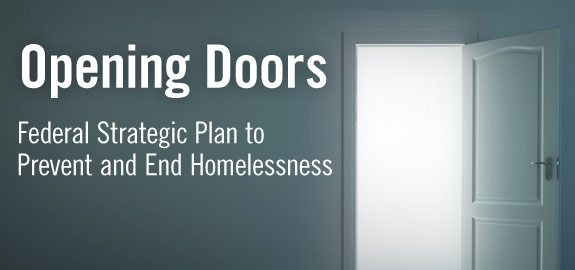It has been one year since the White House and the United States Interagency Council on Homelessness released Opening Doors: Federal Strategic Plan to Prevent and End Homelessness. This article provides an overview of the plan’s goals, objectives, and strategies to end homelessness among individuals, veterans, families, children, and youth in the United States.

On June 22, 2010, the White House and the United States Interagency Council on Homelessness (USICH) released Opening Doors: Federal Strategic Plan to Prevent and End Homelessness. The creation of a plan was mandated through the Homeless Emergency Assistance and Rapid Transition to Housing (HEARTH) Act of 2009. The Plan is built around four goals:
- End chronic homelessness in five years;
- Prevent and end homelessness among veterans in five years;
- Prevent and end homelessness for families, youth, and children in ten years;
- Set a path to ending all types of homelessness.
As a guide to meeting these goals, the Plan lays out ten objectives and fifty-two strategies for implementation.
The USICH is made up of 19 federal agencies, all of which address homelessness and related issues in some way through their own unique programs. Member agencies include: the Department of Agriculture, Department of Defense, Department of Education, Department of Health and Human Services (HHS), Department of Housing and Urban Development (HUD), Department of Justice, and the Department of Veteran Affairs.
The Plan is meant to be a roadmap for joint action by USICH member agencies. It encourages collaboration between agencies to align federal programs and resources that provide housing, health, education, and human services. This Plan is meant to strengthen existing partnerships, such as the HUD-Veterans Affairs Supportive Housing (VASH) voucher program, a combined effort to help homeless veterans. It also develops new partnerships, like the Housing and Services for Homeless Persons Demonstration, a combined voucher initiative between HUD, HHS, and the Department of Education.
The Plan also describes four signature initiatives around specific homeless populations: families with children, youth, veterans, and the chronically homeless. Each initiative directly relates to the four main goals of the Plan. There are ten broad objectives to help reach these four goals:
- Provide and promote collaborative leadership;
- Strengthen capacity and knowledge;
- Provide affordable housing;
- Provide permanent supportive housing;
- Increase employment opportunities;
- Improve access to mainstream programs and services;
- Integrate health care with housing;
- Advance health and housing stability for youth;
- Advance health and housing stability for adults; and
- Retool the crisis response system.
The Plan proposes fifty-two strategies that encourage partnership between the federal government, state and local governments, and the private sector. It calls on all stakeholders to employ cost effective, comprehensive solutions to end homelessness. Ending homelessness also requires improved systems and programs at all levels. This Plan calls for a fundamental shift in how the federal government and communities across the country respond to homelessness. It emphasizes that to prevent and end homelessness, targeted programs must be fully integrated with mainstream programs that provide housing, health, education, and human services.
Visit the USICH website for more information on the implementation of Opening Doors: Federal Strategic Plan to Prevent and End Homelessness.
